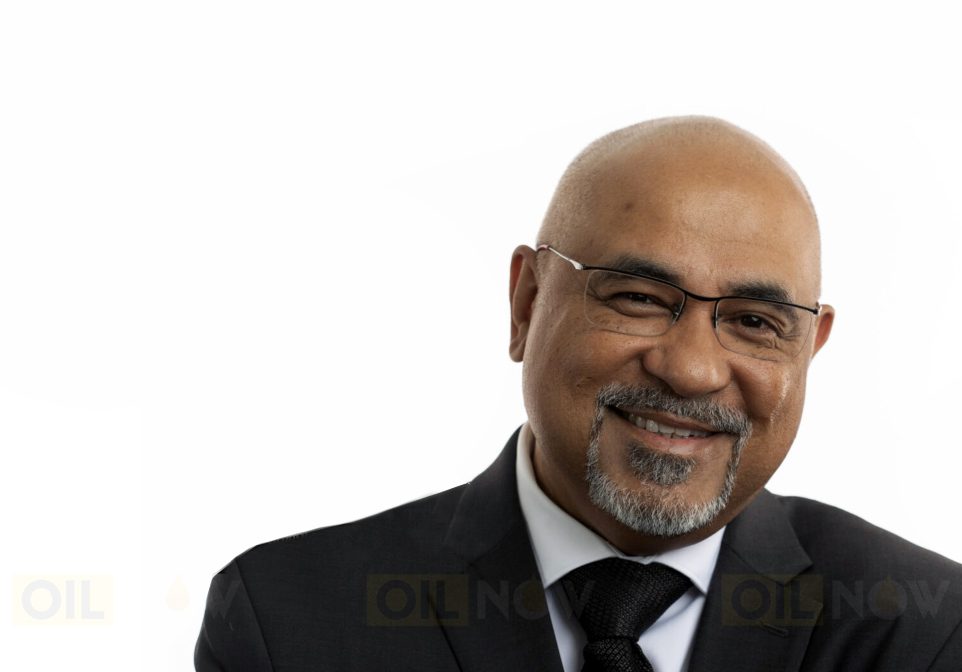While much of the attention over the past few years has been on the significant Stabroek Block discoveries, the Kawa-1 find in the Corentyne Block was one of the major areas of interest for global players that attended the recently concluded International Energy Conference and Expo-2022 at the Guyana Marriott Hotel in Georgetown.
OilNOW caught up with Executive Co-Chairman of CGX Energy Inc., Professor Suresh Narine at the event to better understand how CGX and its partner, Frontera Energy Corporation (FEC) view the interest thus far as well as his perspectives on the importance of the Kawa-1 discovery.
Professor Narine reminded that the Kawa-1 well encountered hydrocarbon-bearing reservoirs within Maastrichtian, Campanian and Santonian horizons based on both Logging While Drilling (LWD) and wireline logs, with over 200 feet of net pay. He said these intervals are similar in age and can be correlated using regional seismic data to recent successes in Block 58 in Suriname and Stabroek Block in Guyana.
Dr. Narine who has an impressive academic career that includes numerous awards including the prestigious “Distinguished Researcher” at Trent University, the “Anthony N Sabga Caribbean Award for Excellence in Science and Technology” and the “Growing Alberta Leadership Award for Innovation” also noted some of the work that went into the success at Kawa-1.
In this regard, he noted that CGX had acquired 3D seismic over the northern sector of the Corentyne block in 2019. Professor Narine said this decision was made following discoveries on the Stabroek Block close to the Northern Boundary of the Corentyne Block and based on encouraging 2D seismic data available and conversations with other Operators in the basin.
Further to this, he explained that the 3D seismic analyses allowed CGX and its JV Partner FEC to review the prospects on the block and increase this to 27. He said prospects in the northern portion of the Corentyne Block are split into 2 complexes, an Eastern and Western Complex. The Kawa-1 drilled the Eastern most of these complexes and tested multiple channel and fan reservoirs. Wei-1, the partners’ next well, will drill the Western segment of this complex.
Expounding further on the Kawa-1 discovery, Professor Narine said it is one of the deepest wells to have been drilled in the Guyana basin, drilling to a final depth of 21,578 feet MD. The rig used for this assignment, the Maersk Discoverer, is a 6th Generation semi-submersible mobile drilling unit capable of operating in 3,000 meters water depth. Its primary features are a 15,000-psi rated well control system, a dual activity derrick, and a moored capability with dynamic positioning.
Professor Narine said these features made it an excellent fit for the Kawa-1 well’s subsurface conditions, drilling requirements and the water depth on location.
With respect to the significance of the discovery just months before the government heads out to its first bid round, Professor Narine said, “The Kawa results are encouraging in that they push the established regional trends further upslope than established deepwater discoveries and has the impact of potentially extending the so-called golden trend updip. As the first non-Stabroek block discovery in the Maastrichtian, Campanian and Santonian horizons, I would expect that this will certainly encourage increased interest in the slope of the basin as has been noted by other commentators such as Wood Mackenzie.”
As regards the response of the market to Kawa-1, Professor Narine said CGX’s shareholders have been a dedicated group of very special people while noting that they have supported the Company through tough times and over a very long time, including when the company was chased off a rig by a gunboat. “They supported us in the following period where CGX funded the Government of Guyana’s appeal to the United Nations Law of the Sea Tribunal and celebrated with us and Guyana when together we won the appeal and helped to re-draw Guyana’s maritime boundary. They have responded to this discovery with characteristic confidence and pride – I am proud and pleased to still be on this journey with them as we continue to evaluate Kawa-1 and explore the block with Wei-1 slated to be drilled in the second half of 2022,” the Executive Co-Chairman stated.
As reported before by OilNOW, the Wei-1 prospect is next in line for CGX and Frontera. In this regard, Professor Narine revealed that this target was developed through the analysis of 3D seismic over the northern portion of the Corentyne Block.
He noted that Wei-1 will be drilled in approximately 1900 feet of water to the Northwest of the Kawa location while adding that Wei will target stacked channel facies in the Maastrichtian, Campanian, Santonian and Coniacian. Professor Narine said this will be the second slope well drilled in the basin, Kawa-1 being the first. Wei-1 will be drilled with the same rig, the Maersk Discoverer, and using the same team that drilled Kawa-1.
Additionally, Professor Narine noted that Kawa-1 has established a working hydrocarbon system and significantly de-risks hydrocarbon source and migration as well as reservoir quality into this portion of the Guyana basin. He said the spud date for Wei-1 is likely to be in the second half of 2022.
With respect to how he sees this new chapter of the Guyana oil story unfolding, Professor Narine shared that Guyana is definitely a target for Foreign Direct Investment, given the massive commercial discoveries that have been made here, the promise of additional discoveries and the concomitant exploration, developmental and support activities that the Oil and Gas sector provides.
He reminded that CGX has also invested in a deep-water port in Berbice.
“However, as also a scientist who has spent many years working with sustainable technologies in and among Guyana’s indigenous peoples in our majestic and incomparable hinterland, I also am very certain that many of the investors that come seeking black gold will discover our sustainable green gold and will partner with us in the sustainable development of this incomparably blessed country,” the Executive Co-Chair concluded.



